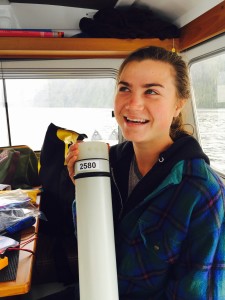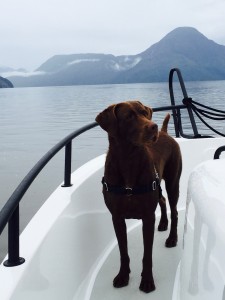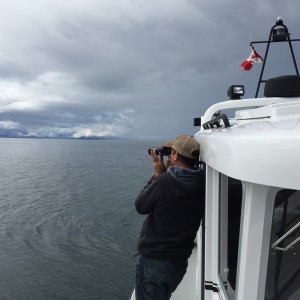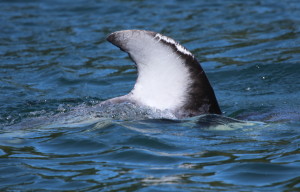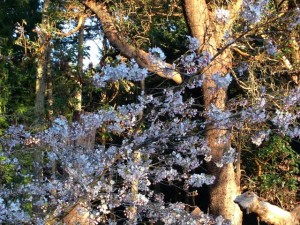
It was another beautiful day in the North Island neighborhood and Team Dolphin was all aboard our trusty research vessel, Wishart. We were cruising up Tribune Channel in search of our study animal, the Pacific white-sided dolphin (Lagenorhynchus obliquidens). The water was a magnificent pale blue—a reflection of the late-summer sky, and an indicator that this channel was once the path of an enormous glacier, which carved out the intricate valleys that make up the channels and inlets of the Broughton Archipelago.
All eyes were squinted against the glare as we scanned the waves for fins or splashes—any indication that there were dolphins in our midst. Off in the distance, three tall columnar blows gave away the position of a group of three humpback whales (Megaptera novaeangliae) making their way down the channel in our direction. We decided to slow our course in order to snap a few ID shots. We waited a few minutes for another surfacing and then, as if on cue, three more blows erupted through the surface almost in unison. One right after the other, each whale turned and dove deep into the blue water, flipping their tails and exposing their flukes as they descended. Armed with rapid reflexes and two spectacular cameras, Rob and I were able to grab ID shots for each whale in the short window of time that their flukes were vertical and above the water.
This is a photo I took from that encounter. The dark parallel lines you see are killer whale (Orcinus orca) rake marks that this whale probably sustained during a run-in with a transient orca. The scars left behind will help lead to an individual identification of this particular whale. Even after seeing them almost everyday this month, the size and agility of these creatures still astounds me.
The humpback’s smaller and speedier cetacean cousins, the Pacific white-sided dolphins, had the spotlight this season for Erin and Rob’s research project. They were quite a bit trickier to photograph than the humpback whales because of their speed and unpredictable behavior. After a month of working with them almost every day and shooting thousands of photos, I feel like I am finally getting the hang of it. Photographing wildlife can be a challenging experience, but with the right amount of patience, persistence, and positivity, the results are incredibly rewarding.
My favorite job on the boat was operating the hydrophone. Like photography, there was a bit of a learning curve. It took quite a few tries to get the hang of wrangling the long wire and recording in time to catch some vocalizations. Sometimes the dolphins would suddenly change their behavior and squall away at high speeds out of the detection range. Sometimes they were just silent. However sometimes, once the engine was off, the hydrophone was in the water, and the recorder and amplifier were switched on (given the batteries were charged and the SD card was in its slot), the voices that came through my headphones were simply breathtaking. This piece of equipment allowed me to access an underwater world that few people are lucky enough to experience. Listening to their whistles and calls as they communicated with each other and to their buzzes and clicks as they echolocated in search of food, added a whole new dimension to observing their behavior at the surface. It gave me a new appreciation for their complex sociality as well as the impact that ocean noise must have on their daily lives.
This is just a taste of a few of the wonderful experiences I have had this month during my Experiential Learning internship working with Oceans Initiative. I’m sad to leave the dolphins behind as this season comes to a close, but I am looking forward to working with Rob and Erin more this winter to help analyze the acoustic data we have been collecting over the last month for my Keystone thesis project at Quest University.
I have learned so much about the many different aspects that are involved in researching cetaceans. I can’t thank Erin, Rob, and Doug enough for being patient mentors and for making my dream come true by bringing me along to Malcolm Island for their field season. Thank you to Clara for the giggles, the sing-along-life-lessons, and for being such a trooper. Thank you MaryAnn for your generosity, warmth, and fabulous suppers. And finally, thank you to the unsinkable Molly Brown Dog for the slobbery kisses, being the best team mascot, and for always being there to keep my hands warm on the boat.
Laura Bogaard
September 24, 2016
